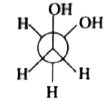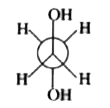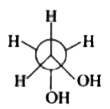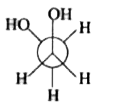Consider the following four liquids :
1.Water : highly polar, H−bonging 2. Hexanol : slightly polar, some H−bonding
3.Chloroform : slightly polar, noH−bonding 4. Octane : non-polar , no H−bonding
Which pair of liquids is immiscible ?
The solutions of water and octance are immiscible. Why?
The correct Answer is:Due to dissimilar intermolecular forces, water and octane are immiscible.
To determine which pairs of liquids are immiscible, we need to analyze the polarity and hydrogen bonding characteristics of each liquid.
1. Identify the Polarity and Hydrogen Bonding of Each Liquid:
- Water: Highly polar, capable of hydrogen bonding.
- Hexanol: Slightly polar, capable of some hydrogen bonding.
- Chloroform: Slightly polar, no hydrogen bonding.
- Octane: Non-polar, no hydrogen bonding.
2. Apply the Principle of "Like Dissolves Like":
- Polar liquids tend to mix well with other polar liquids.
- Non-polar liquids tend to mix well with other non-polar liquids.
- Polar and non-polar liquids do not mix well (immiscible).
3. Evaluate Possible Pairs:
- Water and Hexanol: Water is highly polar, hexanol is slightly polar. They may have some miscibility due to hydrogen bonding, but it will be limited.
- Water and Chloroform: Water is highly polar, chloroform is slightly polar. They are likely to be immiscible due to the lack of significant hydrogen bonding.
- Water and Octane: Water is highly polar, octane is non-polar. They are immiscible.
- Hexanol and Chloroform: Both are slightly polar but have no hydrogen bonding. They may be somewhat miscible, but not completely.
- Hexanol and Octane: Hexanol is slightly polar, octane is non-polar. They are likely to be immiscible.
- Chloroform and Octane: Chloroform is slightly polar, octane is non-polar. They are likely to be immiscible.
4. Conclusion on Immiscibility:
- The pairs that are immiscible are:
- Water and Octane
- Water and Chloroform
- Hexanol and Octane
- Chloroform and Octane
5. Why are Water and Octane Immiscible?
- Water is highly polar, while octane is non-polar. According to the principle of "like dissolves like," these two liquids do not mix well, leading to immiscibility.
Final Answer:
The pair of liquids that is immiscible is Water and Octane. They are immiscible because water is highly polar and octane is non-polar.
- Water: Highly polar, capable of hydrogen bonding.
- Hexanol: Slightly polar, capable of some hydrogen bonding.
- Chloroform: Slightly polar, no hydrogen bonding.
- Octane: Non-polar, no hydrogen bonding.
- Polar liquids tend to mix well with other polar liquids.
- Non-polar liquids tend to mix well with other non-polar liquids.
- Polar and non-polar liquids do not mix well (immiscible).
- Water and Hexanol: Water is highly polar, hexanol is slightly polar. They may have some miscibility due to hydrogen bonding, but it will be limited.
- Water and Chloroform: Water is highly polar, chloroform is slightly polar. They are likely to be immiscible due to the lack of significant hydrogen bonding.
- Water and Octane: Water is highly polar, octane is non-polar. They are immiscible.
- Hexanol and Chloroform: Both are slightly polar but have no hydrogen bonding. They may be somewhat miscible, but not completely.
- Hexanol and Octane: Hexanol is slightly polar, octane is non-polar. They are likely to be immiscible.
- Chloroform and Octane: Chloroform is slightly polar, octane is non-polar. They are likely to be immiscible.
- The pairs that are immiscible are:
- Water and Octane
- Water and Chloroform
- Hexanol and Octane
- Chloroform and Octane
- Water is highly polar, while octane is non-polar. According to the principle of "like dissolves like," these two liquids do not mix well, leading to immiscibility.
The pair of liquids that is immiscible is Water and Octane. They are immiscible because water is highly polar and octane is non-polar.
Topper's Solved these Questions
- SOLUTIONSBOOK - RESONANCE ENGLISHCHAPTER - SOLUTIONSEXERCISE - EXERCISE-2(PART-2)
37 Videos
- SOLUTIONSBOOK - RESONANCE ENGLISHCHAPTER - SOLUTIONSEXERCISE - EXERCISE-2(PART-4)
4 Videos
- SOLUTIONSBOOK - RESONANCE ENGLISHCHAPTER - SOLUTIONSEXERCISE - EXERCISE-1(PART-3)
3 Videos
- SOLUTION AND COLLIGATIVE PROPERTIESBOOK - RESONANCE ENGLISHCHAPTER - SOLUTION AND COLLIGATIVE PROPERTIESEXERCISE - PHYSICAL CHEMITRY (SOLUTION & COLLIGATIVE PROPERTIES)
52 Videos
- STEREOISOMERISMBOOK - RESONANCE ENGLISHCHAPTER - STEREOISOMERISMEXERCISE - EXERCISE (PART III : PRACTICE TEST-2 (IIT-JEE (ADVANCED PATTERN))
23 Videos
Similar Questions
Knowledge Check
Which of the following conformers of 1, 2-diol cannot form intramolecular H-bond?
A B
B C
C D
D
Consider the following orders:
(1) H2SO4>H2SO3:boiling point
(2) H2O>HF: Extent of H-bond
(3) H2O<H2O2: Strength off H-bond.
View SolutionWhich of the following is the correct order of bond angle in H2S, NH3, BF3 and SiH4?
View SolutionAnswer the following :
(a) CCl4 is non-polar but CH3Cl is polar.
(b) SiF4 is non-polar although Si-F bonds are polar.
(c ) A hetero-diatomic molecule is always polar.
View SolutionWhich of the following statements are correct?
1. A σ bond is stronger than a π bond
2. A covalent bond is stronger than a hydrrogen bond
3. HF is more polar than HCl
4. There is one electrovalent bond and three covalent bonds in methylene chloride Select the correct answer using the codes given below
View SolutionAssertion: The surface tension of water is more than other liquid.
Reason: Water molecules have strong intermolecular H-bonding as attractive force.
View SolutionStatement-1 : Intramolecular H-bonding have no effect on boiling point
Statement-2 : Nature of hydrogen bonding is non-directional .
Statement-3 : Covalent bond is directional .
View SolutionWhich out of N2 and H2O is polar and why ?
View Solution
